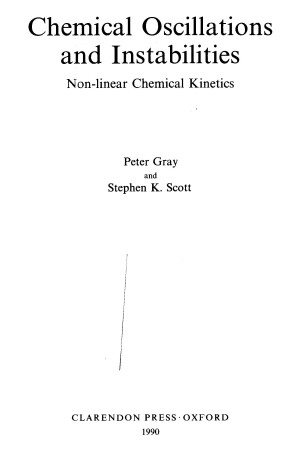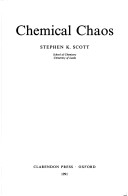International Series of Monographs on Chemistry
2 primary works
Book 21
Scientists in many fields are now expressing considerable interest in non-linearity and the ideas of oscillations and chaos. Chemical reactions provide perfect examples of these phenomena, as oscillating reactions, explosions, ignition, travelling waves, patterns, quasiperiodicity and chaos are all features of chemical kinetics. This book introduces non-linear phenomena in chemical kinetics using simple model schemes. These models involve chemical feedback, such as chain branching, autocatalysis and self-heating. The emphasis is on physical and pictorial representation and on identifying those gross features which are essential. The experimental conditions under which such behaviour will occur can be predicted using simple mathematical recipes, and these are also included. The first part of the book begins with a discussion of long-lived oscillations for autocatalytic or exothermic reactions in closed vessels. Stationary states, bistability and oscillations in continuous flow reactors and diffusion cells are then considered. This is followed by chemical wave propagation and by pattern selection and formation.
Heterogeneous reactions are discussed, as they can also exhibit bistability and oscillations. Complex oscillations, quasiperiodicity and chemical chaos, either forced or spontaneous, are introduced. Part 2 deals with real experimental systems, describing observed experimental behaviour and its interpretation in terms of the underlying chemical mechanisms or simplified models. The Belousov-Zhabotinskii reaction is discussed in some detail as the most extensively studied system, and the behaviour of important gas phase reactions is presented.
Heterogeneous reactions are discussed, as they can also exhibit bistability and oscillations. Complex oscillations, quasiperiodicity and chemical chaos, either forced or spontaneous, are introduced. Part 2 deals with real experimental systems, describing observed experimental behaviour and its interpretation in terms of the underlying chemical mechanisms or simplified models. The Belousov-Zhabotinskii reaction is discussed in some detail as the most extensively studied system, and the behaviour of important gas phase reactions is presented.
Book 24
Chaos theory challenges fundamental ideas in all areas of science, and many of the best examples arise in chemistry. Reactions can become unrepeatable and unpredictable, even though they remain governed by traditional rate equations. Despite the complex appearance of the overall behaviour, the underlying mechanisms are quite simple, and the basic building blocks for chaos - nonlinearity and feedback - both occur quite naturally in chemical systems. Chaos does not appear suddenly or at random, but is created through one of a small number of highly ordered sequences of increasing complexity. These sequences are comprised of qualitative changes in behaviour or "bifurcations". This account of chemical chaos reviews both theory and experiment, emphasizing the simple features that combine to produce "order within disorder". The author begins by revealing the links between chemical kinetics and the interdisciplinary subject to dynamical systems. Various bifurcation sequences are then introduced through representative model schemes, with the emphasis on generality and simplicity.
Chaos arises in both conventional chemical reactions and forced or coupled systems, and both are considered here. Various experimental and diagnostic techniques to test for chaos are then described, and the remaining chapters review experimental studies in a wide range of chemical and biochemical systems.
Chaos arises in both conventional chemical reactions and forced or coupled systems, and both are considered here. Various experimental and diagnostic techniques to test for chaos are then described, and the remaining chapters review experimental studies in a wide range of chemical and biochemical systems.

